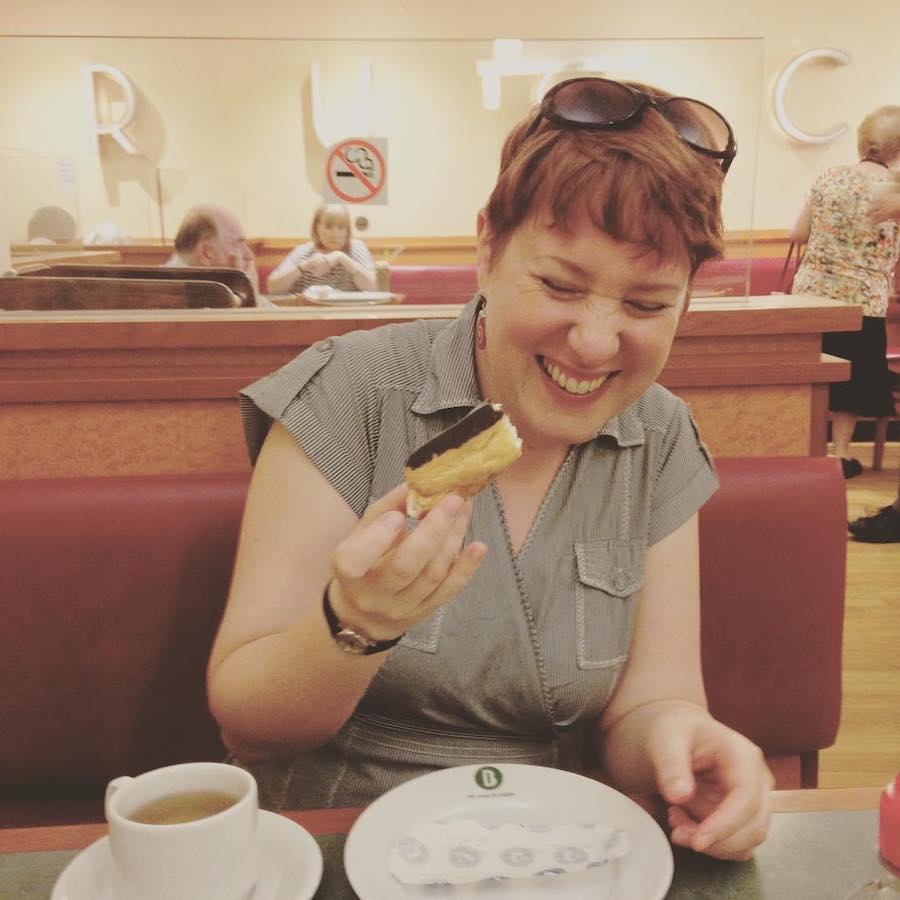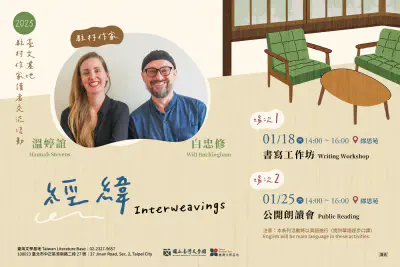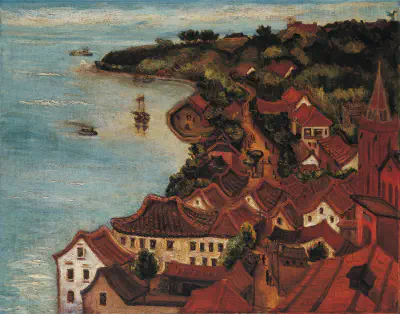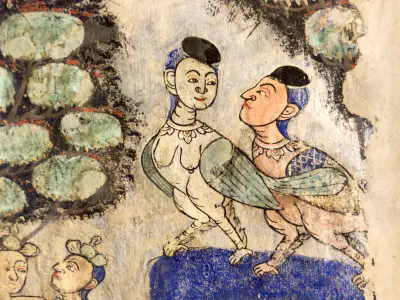This piece was first published in the journal Museum & Society back in 2018. I’m republishing it here to coincide with the fifth anniversary of Elee’s death.
There is a tuna skeleton in the Oxford University Museum of Natural History. It is beautifully displayed in a wood and glass case. Its jaws gape, and whenever I see it, I am reminded of quite how big tuna are.
But there is something else about the skeleton that is strange and wonderful. Because if you stand in front of it, and if you crouch down (you need to crouch!), when you look into the fish’s mouth, you can see all the way to its tail.
There is something topsy-turvy, something both fascinating and funny, about looking into the mouth of a fish and seeing its tail.
It was Elee Kirk—my long-time partner, collaborator, and friend—who first introduced me to the topsy-turvy tuna. Elee did her doctoral research in the Oxford University Museum of Natural History. She knew the museum intimately. She worked there with young children aged four and five, giving them cameras, asking them to photograph exhibits. When the children had finished scooting round the museum taking snapshots, Elee interviewed them about the images they had taken. Like many of the best pieces of research, it was deceptively simple. And it was amazingly fruitful.
On one visit to the Oxford University Museum of Natural History, Elee took me to see the skeleton. ‘Crouch down,’ she said. ‘Look through the jaws.’
I did as I was told, peering between the teeth of the giant fish.
‘Look!’ Elee said. ‘Can you see its tail?’
I confirmed that I could.
Then Elee crouched down next to me and looked as well. When we were both standing upright again, I looked round at her. She was beaming in delight.

There are many ways of looking at a tuna skeleton. Elee owed this particular way of looking to a boy she called Kyle, who took part in her research. Kyle was not his real name: she gave all her child research subjects pseudonyms. But I now think of the tuna as Kyle’s Tuna. It was Kyle who took the photograph. It was Kyle who taught her how to look through those toothy jaws to see the tail at the other end.
When Elee interviewed Kyle about his photograph, the conversation went something like this:
Elee: What’s that a picture of?
Kyle: A salmon.
Elee: A salmon?
Kyle: Yeah, it looks like a dinosaur one.
Kyle’s mum: It’s a tuna fish, Kyle, I think.
Elee: It does look like … why does it look like a dinosaur?
Kyle: Because it looks like a swimming, um … dinosaur like the … um …
Elee: The bones, do you mean?
Kyle: Yeah, um … a swimming dinosaur bones.
A swimming dinosaur bones! I love that expression. A swimming dinosaur bones, the tail of which is visible when you peer through its mouth: what a strange and remarkable thing that is!
As Elee’s research developed, Kyle’s idiosyncratic way of viewing the tuna skeleton took on an emblematic significance. It was a reminder that the way children see the world is not the way adults see the world, that their perspectives, quite literally, are different. It was a demonstration of the sheer creativity of children’s ways of seeing. And it brought home to her the pleasure that can be derived from entering into these new ways of seeing.
In the summer of 2016—just over a year after being awarded her PhD in museum studies, and only a few months after she began working as Senior Lecturer at the Institute of Education in London—Elee passed away. She died of breast cancer that spread to her liver and bones. She was thirty-eight years old. On her death, Elee left behind her unpublished thesis—with the magnificent title Crystal Teeth and Skeleton Eggs—as well a small body of published papers and a plan for an eventual book. She also left behind a network of friends and colleagues who had been inspired, moved and provoked by her work, some of whom are published in this special issue of Museum and Society.
I am not a museologist, nor am I an expert in childhood studies. Instead, I am an interloper into both of these fields, a fascinated outsider who, over the years, spent many hours talking to Elee about her work. So, when I was invited by the editors of this journal to contribute an essay, I was not sure what I had to add. What, I wondered, could I possibly say?
But then I thought of the swimming dinosaur bones in Oxford. I thought of Kyle’s insights. I thought of Elee’s sheer delight in novel ways of seeing things. And I thought that here, perhaps, there was something to be said.
Whilst still at primary school, Elee was asked to imagine what she would be doing when she was thirty years old. She wrote a short piece, and she illustrated it with a drawing. Elee was always good at drawing. She was an inveterate doodler, her notebooks filled with images of penguins and cats and Vikings and foxes, and almost anything that passed through her mind as she was pondering her research. But in this piece that she wrote back in primary school, she drew a neat picture of a small terraced house and a cat, and she wrote about how, at the age of thirty, she would probably be living in a house like this, with a cat as a companion, and spending her days working in a museum.
Her prediction turned out to be more or less right. By her thirtieth birthday, we were living in a terraced house in Birmingham, along with Bod the cat, and Elee was working as an education officer in Thinktank, the Birmingham science museum. Other than me, everything was much as she had pictured it all those years before. There was something in this that was a testament to her single-mindedness, something that showed the extent to which she knew herself and had always known herself.
It was at Thinktank that we first met. Elee had finished studying, taking a degree in human sciences at Oxford and then an MA in science communication at Bath. The post in Birmingham was her first museum job. As for me, I was just passing through the museum, trying to get my act together as a writer, preparing to embark upon a PhD in philosophy.
Elee was committed to her new job. I, on the other hand, was not the best employee. I used to hide in dark corners of the museum, to read or study obscure languages. But Elee and I often found ourselves timetabled on the rota together, walking the galleries; and as far as I was concerned (other than unprecedented opportunities the job gave me for pursuing my own philosophical projects) Elee was one of the best things about the museum. As we walked, we talked. Elee seemed interested in everything. She was thoughtful, funny, insightful, well-informed, both serious and light-hearted at the same time.
After several months, I left the museum, and started on my PhD. Elee stayed on. We remained in touch. I continued to regard her as one of my closest friends. A couple of years later, we started dating. Soon after, we moved in together. Bod the cat appeared a year or so later. I continued to write and started to publish. And Elee continued her work as an education officer, running classroom sessions and shows for tens of thousands of school children. Sometimes, she told me later, when she stood in front of groups of children visiting the museum, she had a sense she was catching glimpses of secret worlds, idiosyncratic perspectives, insights into what the museum meant to their youngest visitors.
For Elee, the experience of museums was deeply felt, personal, intimate, perhaps even a little mysterious. And she could see that this was true for the children who visited these places too. She wanted to know more about why museums really mattered to the children who passed through them. So, back in early 2009, Elee contacted the School of Museum Studies in Leicester, and soon she had enrolled on her PhD.
Elee liked to talk about hedgehogs and foxes. Not just because both were occasional visitors to our back garden, but also because of the essay ‘The Hedgehog and the Fox’, by the philosopher Isaiah Berlin (1953). In this essay, Berlin took up the curious saying attributed to the Greek poet Archilochus, ‘a fox knows many things, but a hedgehog one important thing’, and he used it as a way of classifying writers and thinkers. Writers like Plato, Lucretius and Proust, Berlin said, were hedgehogs. Over in the fox camp, on the other hand, were the likes of Aristotle, Montaigne, and James Joyce. Elee liked to claim that she was a hedgehog whilst I was a fox. And it is true that her single-mindedness, her unwavering commitment to museums from primary school age until her death, her careful, methodical approach to life—all these seemed to be particularly hedgehogly traits. If there was one big thing that Elee knew about, it was museums—whereas there is no one big thing that I know about. Not one.
But when I think about her now, I can see that Elee wasn’t a hedgehog at all. Not really. There was something decidedly fox-like about her omnivorous curiosity. If she was interested in museums, it was because museums were a way of opening up entire worlds. Museums mattered to Elee because in a single visit, you could indulge a fox-like enthusiasm for many things. And where else could you do that? If a museum is one big, important thing, it is one big, important thing that contains a myriad of little things.
Elee was a fox in hedgehog’s clothing. Or perhaps she was some kind of hybrid, neither fully hedgehog nor fox, a hedgefox or a foxhog. Maybe this is the case for all those who love museums, and who dedicate their lives to them.
Elee eventually settled on the Oxford University Museum of Natural History as a place to do her research. It was a big, important looking place, almost archetypally old-school. Elee adored the architecture, the balconies where you could spend hours idly people-watching, the glass roof that flooded the building with light. But this big, important thing that was the Oxford museum was also a place that contained an array of many smaller things—things that brought Elee immense joy. A parade of mammal skeletons! Plesiosaurs, Ichthyosaurs and Utahraptors! Ammonites and chunks of sparkling pyrite! Dodos! Bees in their hive, half-way up the stairs! Doing waggle dances!
And foxes, incidentally. And hedgehogs too.
One of the things that made Elee’s research so very fruitful was that, through the medium of photography, she found a way in which she could listen to the concerns, enthusiasms, and obsessions of the children who visited the museum.
The ability to listen—to truly listen—is a rare thing; but Elee was peculiarly good at listening, to a sometimes unsettling extent. After meeting her, people commented on it. And in those early conversations when we worked together in the science museum in Birmingham, this attentiveness, the intensity of her listening, sometimes wrong-footed me. She was alive not just to what was said, but also to context and to subtext. It made talking with her a delight, but when you chatted with Elee, even if it was just a casual conversation, you felt as if you had to keep your wits about you.
In the weeks before she died, Elee and I talked a lot about what mattered most to her. The thing she said again and again was that she believed in the virtue of listening. First listen, then speak, she said. Because if you don’t listen, how do you know what to say? If you don’t listen, how is there anything to talk about at all? There was a bracing pragmatism in this. It was about data. If you don’t listen, you can’t know what is going on. If you don’t listen, you close yourself down to what other people are telling you. If you don’t listen, you close yourself down to what the world is saying.
Elee’s research was, above all, about finding ways of listening to children who visited the natural history museum in Oxford. Her desire to listen transformed her from museum educator to a museum researcher. Elee took the metaphor of children’s ‘one hundred languages’ from the Reggio Emilia educational approach (Edwards et. al. 1998), and she set about developing ways of listening more, and listening better, to children in the museum. Because one thing that Elee was clear on was this: that children should be taken seriously not just as children, but as human beings for whom the world was already, here and now, fully rich and meaningful.

For Elee, photography was the ideal way of listening. Not just to what was said, but to the context and the subtext. Her research gave children’s own concerns and obsessions, quirks and passions room to breathe. And Elee’s interviews with make for delightful, surprising, and insightful reading. Take, for example, this interview with Karen, discussing Karen’s photograph of a polecat, a moorhen (which Karen identifies as a ‘duck’), and some flowers.
Elee: Okay, so it’s sort of a long thin animal isn’t it? In a glass box. So why did you like this one?
Karen: ’Cause I liked the long tail.
Elee: You liked its tail? Did you? What do you think it’s doing?
Karen: Um… climbing up… climbing up the rock to get some food.
Elee: Oh, what do you think it eats? […] Do you know? No? Okay, so what else do you like about this?
Karen: Um […] Because… because it, it has flowers.
Elee: You like the flowers in it as well do you? Okay. So you like this animal here because of its long tail.
Karen: Yeah. Yeah, and I like the duck.
Elee: Oh, there’s a duck down there as well. I didn’t spot that. Well done. You’ve got sharp eyes, haven’t you? So you like it…
Father: Maybe it’s going to eat the duck.
Elee: Do you think it’s going to eat the duck?
Karen:It’s looking at the duck. So I think […] I think he’s going to eat the duck.
Elee: Oh, so it’s looking at it so it can eat it? Oh, okay. Wow. Do you want to tell me anything else about this picture?
Karen: Um… because I like his long whiskers.
Elee: You like his whiskers? […] So you like his whiskers and his tail, and the flowers…
Karen: And the flowers and the duck.
The attentive listening here is impressive. The way that Elee reconfirms and reinforces what Karen says with all of those ‘okays’ and ‘wows’, her assiduous determination not to add anything of her own. It is an object lesson in how to listen, and how to listen well. Not just to children, but—for that matter—to anybody.
Elee had always wanted to write a book about her work. She wanted her work to get out there, to have an effect on the world. But after her diagnosis with secondary cancer, she knew time was limited. So one day—once the shock of the diagnosis had begun to settle—we went out to our favourite café, and we ordered lunch. After we had finished lunch, a steaming pot of sencha green tea on the table between us, we made a plan for how to rewrite her thesis, drafting and redrafting an outline for what would be her first book. We both hoped that Elee would have the chance to complete the work herself. She was the best person for the job. But we could not be sure, so we agreed on a plan I could follow, if Elee ran out of time.
I remember that meeting well. The spring sunshine outside. The chill on the air in the draughty upstairs of the café. The heat from the radiator we huddled against to fend off the cold. How we flipped back and forth through her thesis, scribbling notes, crossing bits out, circling other bits. And I remember how, when we talked about the rewrite, a shadow passed across Elee’s face. It was then I first thought that perhaps we did not have time enough, and Elee would never complete the book herself. It had been a rough couple of weeks. Elee’s health had been declining more quickly than we had hoped.
The weeks that followed our summit meeting (we often had these meetings to talk about our ongoing projects, and always thought of them as ‘summit meetings’) were worse. By the early summer, we both knew for certain that Elee would not complete the book.
I said I would do my best to finish it on her behalf, once she was gone.
Of all the editorial jobs I have ever taken on, it was one of the strangest. I drew upon the thesis, our plan, Elee’s notes, and the years of conversations I had shared with Elee. As I wrote and rewrote, I listened as attentively as I could to how Elee’s voice sounded in my head, to her tone, to her particular way of asking questions, to her humour. It was hard to write in the shadow of the book she would have written, but with assistance from friends, colleagues, editors and peer reviewers, I got it done. Snapshots of Museum Experience, Elee’s first and only book, was published by Routledge in July 2018 (Kirk and Buckingham, 2018). And for all the difficulties of the task, Elee made it as easy for me as any writer could. She was not only a fine researcher, but she also crafted beautiful prose. She was a dream to edit. Her sentences were clear and elegant. There was a warmth to her writing that was perpetually delightful. She knew what she wanted to say, and she said it well.
Snapshots of Museum Experience isn’t exactly the book Elee would have written. But I hope it will do her justice, that it will help communicate her work to new audiences, leading to new lines of enquiry, new ways of doing things. Because in the end, Elee was not interested in memorials or monuments. What she was interested in was this: that great, collective effort to understand the world better, and on the basis of this understanding, to make the world better.
Elee would have been pleased, then, had she known about this special issue of Museum and Society. She would be delighted others were taking up her ideas and insights, and following the questions they opened up as they led in new and exciting directions. Because this is what mattered most to her.
So, should you ever find yourself in the museum in Oxford, then—in honour of Kyle, and in honour of Elee—seek out that tuna skeleton. After you have found it, crouch down in front of the display case, and peer through those heavy jaws, looking past the ribs and along the line of the spine all the way down to the tail fins. When you stand up again, I guarantee that the world will seem a little bit richer, a little bit stranger, and a little bit funnier.
Because if Elee has taught me anything, it is this: that it is out of such small shifts in perspective, if we are attentive to them and if we are appreciative of what they might mean, that great things can come.
Works Cited
Berlin, I. (1953). The Hedgehog and the Fox; an essay on Tolstoy’s view of history. New York: Simon & Schuster.
Edwards, C. P., Gandini, L., and Forman, G. E. (1998). The Hundred Languages of Children: the Reggio Emilia Approach. Greenwich, Conn.: Ablex Pub. Corp.
Kirk, E., & Buckingham, W. (2018). Snapshots of Museum Experience: Understanding Child Visitors Through Photography. Abingdon, Oxon: Routledge.
The original of this article can be found on the Museum & Society website, where it is licensed under a CC-4.0 International Licence. See the link here.



